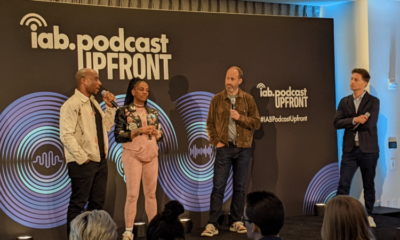SEO
10 Strategic SEO Insights & Tactical Advice For 2023 And Beyond

I’ve written about search engine optimization (SEO) for over 20 years.
So, I wasn’t shocked when the editors asked me to refresh an article I wrote on October 21, 2020, titled “3 Strategic SEO Insights & Tactical Advice for 2021.”
But looking back at what I’d written two-and-a-half years ago, I realized that my actionable insights now need to be thoroughly updated in this era of constant change.
The advent of OpenAI’s ChatGPT on Nov. 30, 2022, has triggered a “code red” at Google, which rushed out a new experimental conversational AI service called Bard in response to Microsoft’s AI-enhanced Bing.
UBS estimates that ChatGPT reached 100 million monthly active users in January, 2 months after its launch. According to the Swiss bank’s analysts, it would be the fastest-growing online application in history.
So, what strategic SEO insights and tactical advice could I share with you today that will still be relevant a year from now?
What critical data or search trends would encourage you to display a motivational poster on your wall that advises everyone to “Keep Calm and Carry On”?
By the way, that last piece of advice is not half bad.
Google was launched on Sept. 4, 1998, and didn’t pass AltaVista to become the leading search engine until the second half of 2002 – about 4 years later.
And even the Panda Update, which shocked the SEO industry and effectively ended the “content farm” business model, only impacted 12% of queries, according to the History of Google Algorithm Updates.
The Penguin Update, which downranked websites that engaged in aggressive webspam, only impacted 3.1% of English queries.
And it’s worth recalling that the first iteration of the Panda Update started on Feb. 23, 2011, but was followed by 27 more adjustments until the final update on July 17, 2015. And the Penguin Update, which began on April 24, 2012, didn’t end until Sept. 23, 2016.
It may take more than four years to know the full impact of Google’s Bard AI or the new AI-powered Bing search engine.
So, SEO professionals would be well advised to “Keep Calm and Carry On.”
That means I can confidently share 10 strategic insights, bits of critical data, pieces of tactical advice, or search trends that will impact SEO in 2023 and beyond without losing too much sleep over the fact that 30% of them may not be relevant a year from now.
(After telling you why “the fundamental things apply as time goes by,” I’ll circle back to explain why a 70% success rate is the right benchmark.)
SEO remains an essential element of any digital marketing strategy.
And even though the search industry is constantly changing, Google is still the leading search engine.
According to Similarweb, Google.com got 3.2 billion unique visitors in January 2023, making it the most visited website globally. The search giant also got 88.3 billion visits in January 2023.
So, don’t bet the farm on Google going away anytime soon.
And if you need to keep other people within your company, or at one of your clients, from rushing off to panic stations, then show them the chart below from Google Trends, which displays worldwide web search interest over the past 90 days for the search terms Google, ChatGPT, and Bing.
You can calmly explain that the dips in interest for Google occur on weekends.
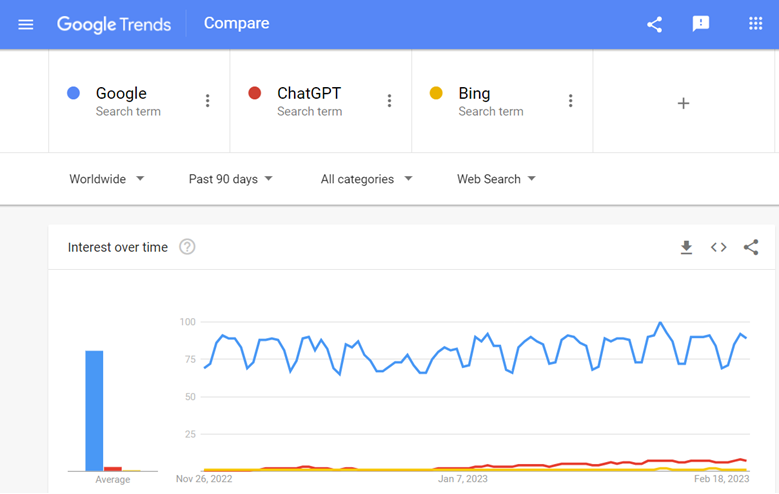 Screenshot from Google Trends, February 2023
Screenshot from Google Trends, February 2023If Google remains the dominant search engine for the foreseeable future, then SEO pros don’t need to be retrained or replaced.
Why? Because they’re already familiar with Google Search Essentials (formerly Webmaster Guidelines).
And they’ve successfully navigated through the 22 Google Search ranking updates.
This is why I’m confident that more than 70% of SEO pros will continue successfully navigating the uncharted areas of keyword maps that bear the phrase: “Here be dragons.”
1. Focus On User Intent
One of the most important aspects of SEO is understanding user intent.
Google’s algorithms have become more sophisticated, and they’re now better able to understand the intent behind a query.
So, SEO pros should focus on creating content that satisfies user intent rather than just targeting specific keywords. This means creating content that is not only relevant to the user’s search query, but also provides helpful information or a satisfying experience.
Now, I realize this strategic insight isn’t breaking news.
But you still might benefit from re-reading my article, The Future of SEO Lies in the ‘Messy Middle’ of the Purchase Journey.
According to research by Google’s Market Insights team in the U.K., the “messy middle” is where people decide what to buy.
Among other things, this research found:
“People look for information about a category’s products and brands, and then weigh all the options. This equates to two different mental modes in the messy middle: exploration, an expansive activity, and evaluation, a reductive activity. Whatever a person is doing, across a huge array of online sources, such as search engines, social media, aggregators, and review websites, can be classified into one of these two mental modes.”
Let me translate this “big idea” into counter-intuitive tactical advice: SEO pros must create and optimize at least two pieces of content to address the user’s different intents in the “messy middle” of the purchase journey.
And, if your company or client is targeting half a dozen different segments, then you need to create and optimize at least a dozen pieces of content.
Creating and optimizing one page for each target segment is so 2019.
2. Create High-Quality Content
Content is still king, but if SEO managers want to become prime ministers (or presidents) someday, then they need to create more original, helpful content written by people, for people.
How can you ensure you’re creating high-quality content? By following Google’s long-standing advice and guidance for core updates to create content for people, not for search engines.
So, let me suggest you re-read my article, What Is A Content Marketing Matrix & Do We Need One?
It shows you how to use a content marketing planning tool to generate ideas for enchanting content that changes hearts, minds, and actions. That’s how you become the VP of SEO.
3. Prioritize E-E-A-T
On Dec. 15, 2022, Google updated its search rater guidelines – adding an extra E for Experience to the concept of E-A-T: Expertise, Authoritativeness, and Trustworthiness.
Although these guidelines don’t directly influence ranking, they are useful for anyone who works in SEO because they give us an idea of where Google wants its algorithms to go.
To improve your content’s E-E-A-T, someone with first-hand life experience on the topic should produce it.
If you can’t convince someone with experience to produce this content in-house, you need to find a freelance writer – or content creator – who has used your product or service, visited a place, or influenced brand purchases.
Unfortunately, many SEO pros still don’t think this is their job – even though the first mention of E-A-T occurred in 2014 when Google added the concept to its Search Quality Guidelines.
Even Google said:
“These are not fundamentally new ideas. And we’re by no means abandoning the fundamental principle that Search seeks to surface reliable information, especially on topics where information quality is critically important.”
If you’d like some practical advice, read How To Find Talented Writers To Fuel Top Quality Content Creation, which includes my interviews with a couple of thought leaders in this field.
4. Optimize YouTube Content
According to the Video & Visual Storytelling Survey by Content Marketing Institute (CMI) published on Oct. 27, 2022, 73% of marketers said videos have become more important to their business in the last year; 27% said they are about the same in importance; and, no one said videos have decreased in importance.
Why should SEO pros lose sleep over this critical data?
Because the content marketing department, not the SEO department, is jumping on this trend.
And that means many of the videos cranked out in 2023 and beyond won’t be optimized for search – let alone integrated into an overall SEO strategy.
So, here’s some tactical advice: first, read Sam Hollingsworth’s guide, YouTube SEO: How To Optimize Videos & Rank Higher.
Next, invite the content marketing department to a brown bag lunch to discuss ways to create great content together.
5. Earn High-Quality Links
Links continue to be one of Google’s most important ranking factors. And at least 70% of SEO pros have already read articles like:
Unfortunately, the lion’s share of chief communications officers (CCOs) and public relations officers (PROs) haven’t read articles like these.
So, only a handful of organizations use one of the most effective techniques to earn links to help your website rank higher on search engines.
Ironically, the biggest barrier is not journalists. Pogo once observed, “We have met the enemy and (they are) us.”
This means you might need to invite your CCO or PRO to a swanky restaurant to discuss link building instead of hosting another brown bag lunch.
But this is a better use of your time and money than trying to figure out a clever way around Google’s December 2022 link spam update, which can now detect both sites buying links and those used to pass outgoing links.
6. Optimize For Local Search
Brick-and-mortar businesses serving specific towns, cities, regions, and states know local search is important.
When done correctly, local SEO enables people to find information about their business, putting them one step closer to making the cash register ring.
And SEO pros specializing in local search know a consistent Name, Address, and Phone number (NAP), local links, local reviews, and star ratings, as well as optimized Google Business Profiles, are important parts of Google’s local search and Local Pack algorithms.
But, to learn the latest trends and tips to help your local business grow using local search optimization, local marketing, and local advertising, read Search Engine Journal’s A Guide to Local SEO, which tackles what you need to know about optimizing for local search.
7. Keep An Eye On Multisearch
In April 2022, Google introduced an entirely new way to search using text and images simultaneously.
With multisearch in Lens, users can go beyond the search box and ask questions about an object or refine their search by color, brand, or visual attribute.
To learn more about this, read Matt G. Southern’s article, Google Multisearch: A New Way To Search With Text & Images.
Then, read Roger Montti’s article, How Does Google Multisearch Affect SEO?
So, keep an eye on multisearch in 2023 and beyond.
8. Keep Your Ear To The Ground For Voice Search
According to Roger Montti’s article, Google: Voice Search Is Not The Future, Google’s Martin Splitt shared his opinion that voice search is not the future and that there will be no need to optimize for it.
Even though I’ve written about Amazon’s Big Game Commercial: Mind Reader twice in the past year, I haven’t paid much attention to voice search until I was prompted to read a couple of recent articles on this topic, including:
And while writing this article, I re-read Kristopher Jones’ How Can Voice Search Benefit Your SEO? He wrote:
- 40.2% of Americans use voice search.
- 71% of people prefer using voice search to physically typing out a search online.
- 27% of the online population worldwide uses voice search on mobile.
- 58% of people have used voice search to find information about local businesses.
In other words, four out of five people with a veritable ton of E-E-A-T think that voice search represents a phenomenal SEO opportunity.
So, keep your ear to the ground for new voice search developments in 2023 and beyond.
9. Migrate To Google Analytics 4 (GA4)
I’ll bet Google sent you an email with the subject line: “We’ll soon configure Google Analytics 4 for you.”
It said:
“For any customer who does not set up a GA4 property with basic settings, starting in March, we will configure one with a few basic settings consistent with the existing Universal Analytics property; this includes certain conversion events, Google Ads links, and existing website tags.”
This means the chaos expected on July 1, 2023, when standard Universal Analytics properties will stop working, has arrived ahead of schedule.
And, as Sun Tzu once observed, “In the midst of chaos, there is also opportunity.”
In my article, Google Analytics 4 Should Trigger Reorganizations & Agency Reviews, I said the advent of GA4 would cause the marketing department to start “freaking out” if the web analytics team – which still sits in the IT department in far too many organizations – doesn’t respond to urgent requests for “help” within a week, a day, or even an hour.
So, this is the perfect time for you to make the business case for moving the analytics team out of the IT department and into the SEO department.
If there’s any pushback, remind decision-makers that 53.3% of all website traffic comes from organic search, according to BrightEdge Research.
10. Build A War Room
If you’re a chief marketing officer (CMO) or vice president of Marketing and you move the analytics team into the SEO department, your team may ask to build a dashboard. Build a war room instead.
Why? Because “most dashboards tend to stink when it comes to helping the Executive make any decisions,” according to Avinash Kaushik, the Digital Marketing Evangelist for Google.
This is because the interpretation of the “easy-to-understand visuals” in most dashboards is left to the executive.
But most war rooms feature not only maps of the global market and charts of the company’s key performance indicators (KPIs), but also an analytics and insights manager with the experience, expertise, authoritativeness, and trustworthiness to interpret the trends and add context.
This “Analysis Ninja” can explain to executives why some key trends are up or down (in plain English).
And over time, executives will begin to ask their analytics and insights manager to recommend which actions or steps should be taken to move the dial.
And an Analysis Ninja can answer the question, “As a result of this trend (up or down) what was the impact on the company and its customers?”
Why Should SEO Pros Adopt The 70% Solution?
Now that I’ve shared 10 strategic SEO insights and some counter-intuitive tactical advice for 2023 and beyond, I’ll circle back to explain why a 70% success rate is the right benchmark.
Ty Kiisel’s article, 70% Solution: The Marine Corps Framework for Making Battlefield Decisions, should be required reading for every SEO manager who wants to become the VP of SEO someday.
The Marines teach their young officers what they call the 70% solution.
And it could be a good strategy to adopt for making decisions in situations where you don’t have all the information or resources you’d like.
In a perfect world, you’d have all the critical data you need to make informed decisions. But we don’t live in a perfect world.
Nevertheless, if you have 70% of the information you’d like to have, then you can still make good decisions – provided you accept the notion that you may need to adjust and compensate for the critical data you lack as you move forward.
And like battlefield commanders, most SEO managers never have all the resources they need to meet their objectives.
But it can sometimes be enough if you have good people and 70% of what you need. And finding creative solutions to challenges is a hallmark of successful SEO professionals.
Finally, are you 70% confident that your plan will succeed?
In other words, do you feel good about your plan’s success with the information and resources you have?
The Marines believe a well-conceived plan, along with taking the initiative, is more likely to succeed than doing nothing.
This is why I can confidently share 10 strategic insights, bits of critical data, pieces of tactical advice, or search trends that will impact SEO in 2023 and beyond without losing too much sleep over the fact that 30% of them may not be relevant a year from now.
The Marines have given us a framework for making decisions in less-than-ideal circumstances.
That is why you should “Keep Calm and Carry On.”
More Resources:
Featured Image: Monster Ztudio/Shutterstock
SEO
How To Use ChatGPT For Keyword Research

Anyone not using ChatGPT for keyword research is missing a trick.
You can save time and understand an entire topic in seconds instead of hours.
In this article, I outline my most effective ChatGPT prompts for keyword research and teach you how I put them together so that you, too, can take, edit, and enhance them even further.
But before we jump into the prompts, I want to emphasize that you shouldn’t replace keyword research tools or disregard traditional keyword research methods.
ChatGPT can make mistakes. It can even create new keywords if you give it the right prompt. For example, I asked it to provide me with a unique keyword for the topic “SEO” that had never been searched before.
“Interstellar Internet SEO: Optimizing content for the theoretical concept of an interstellar internet, considering the challenges of space-time and interplanetary communication delays.”
Although I want to jump into my LinkedIn profile and update my title to “Interstellar Internet SEO Consultant,” unfortunately, no one has searched that (and they probably never will)!
You must not blindly rely on the data you get back from ChatGPT.
What you can rely on ChatGPT for is the topic ideation stage of keyword research and inspiration.
ChatGPT is a large language model trained with massive amounts of data to accurately predict what word will come next in a sentence. However, it does not know how to do keyword research yet.
Instead, think of ChatGPT as having an expert on any topic armed with the information if you ask it the right question.
In this guide, that is exactly what I aim to teach you how to do – the most essential prompts you need to know when performing topical keyword research.
Best ChatGPT Keyword Research Prompts
The following ChatGPT keyword research prompts can be used on any niche, even a topic to which you are brand new.
For this demonstration, let’s use the topic of “SEO” to demonstrate these prompts.
Generating Keyword Ideas Based On A Topic
What Are The {X} Most Popular Sub-topics Related To {Topic}?
The first prompt is to give you an idea of the niche.
As shown above, ChatGPT did a great job understanding and breaking down SEO into three pillars: on-page, off-page & technical.
The key to the following prompt is to take one of the topics ChatGPT has given and query the sub-topics.
What Are The {X} Most Popular Sub-topics Related To {Sub-topic}?
For this example, let’s query, “What are the most popular sub-topics related to keyword research?”
Having done keyword research for over 10 years, I would expect it to output information related to keyword research metrics, the types of keywords, and intent.
Let’s see.
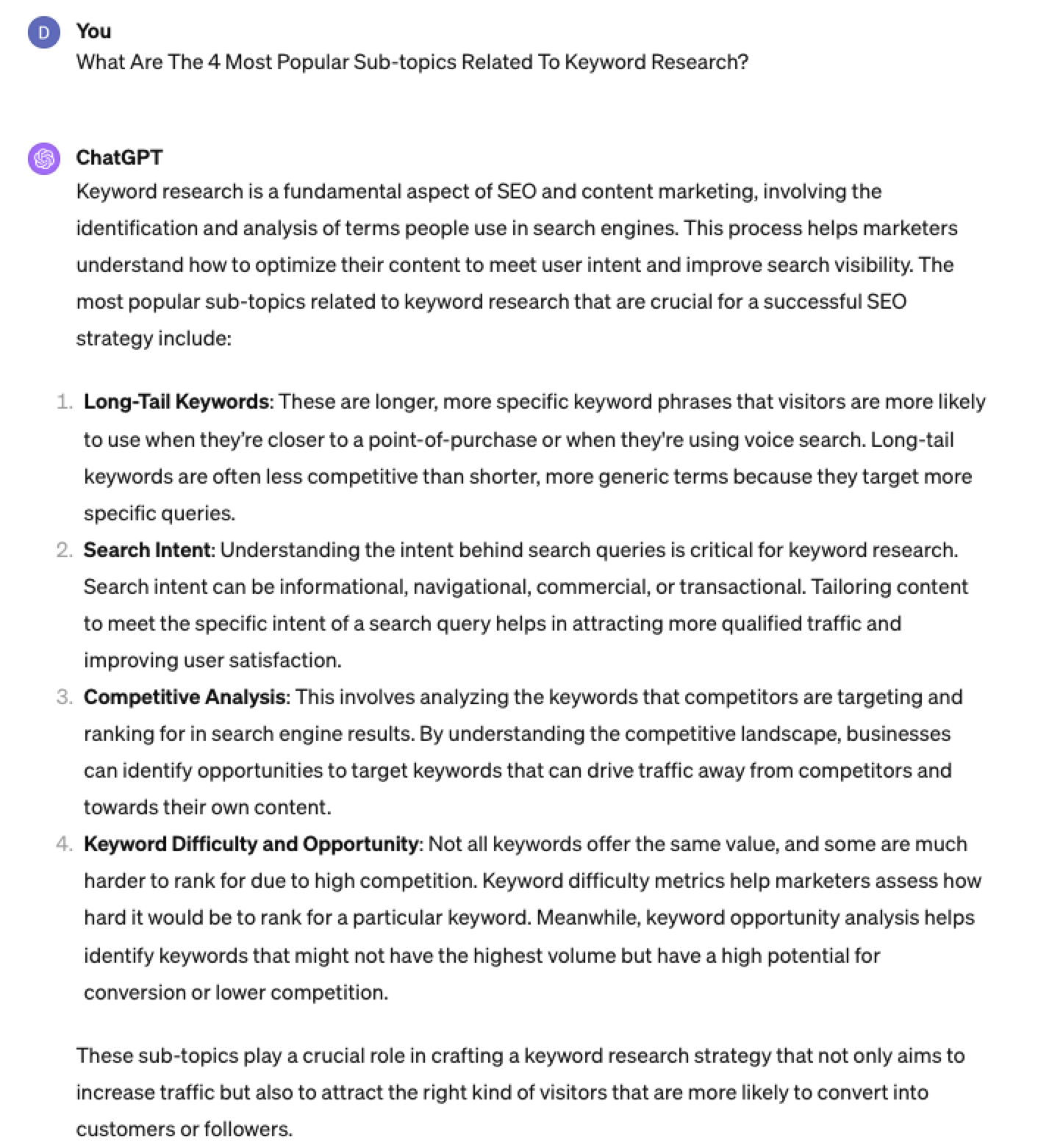 Screenshot from ChatGPT 4, April 2024
Screenshot from ChatGPT 4, April 2024Again, right on the money.
To get the keywords you want without having ChatGPT describe each answer, use the prompt “list without description.”
Here is an example of that.
List Without Description The Top {X} Most Popular Keywords For The Topic Of {X}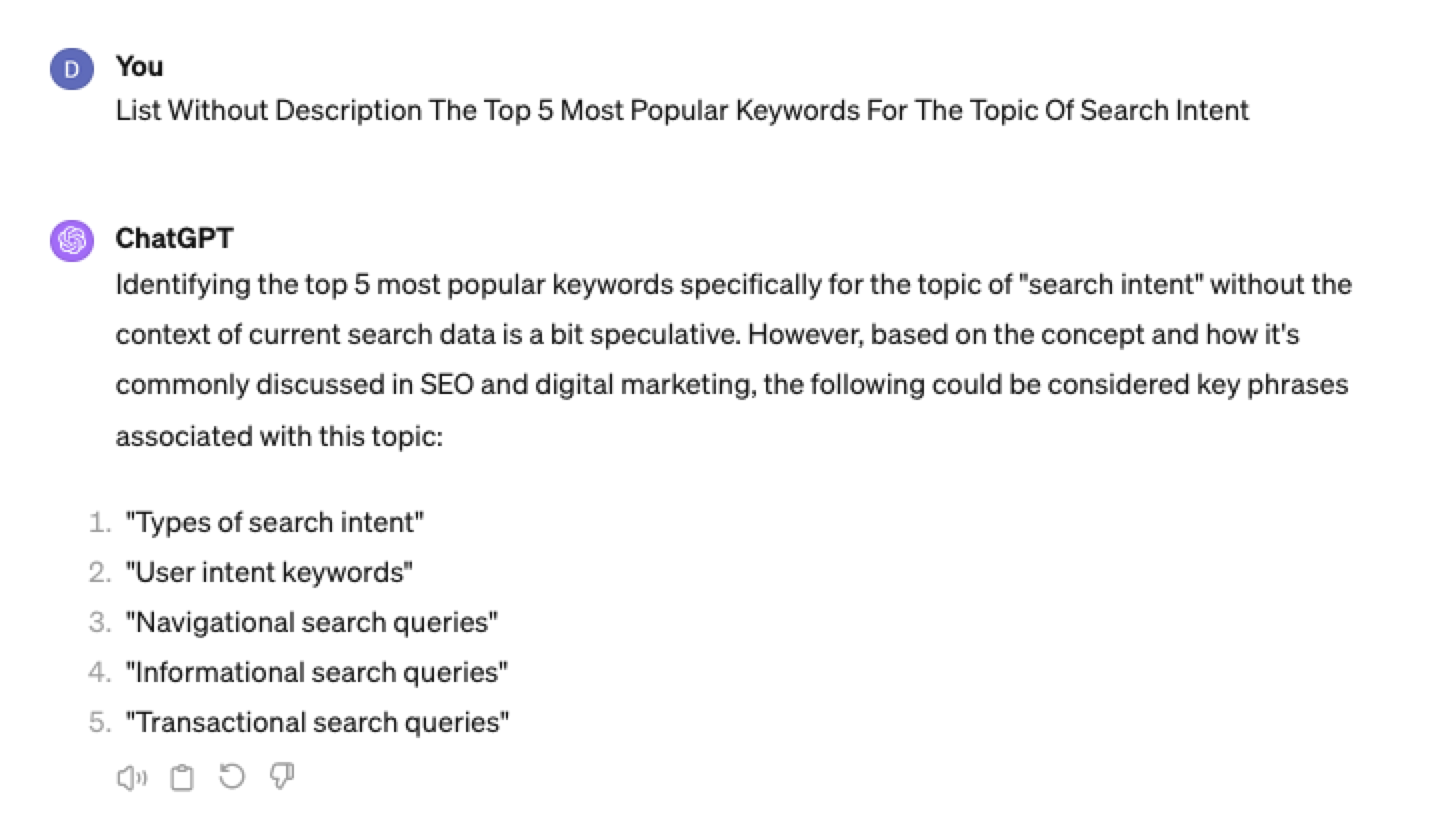
You can even branch these keywords out further into their long-tail.
Example prompt:
List Without Description The Top {X} Most Popular Long-tail Keywords For The Topic “{X}”
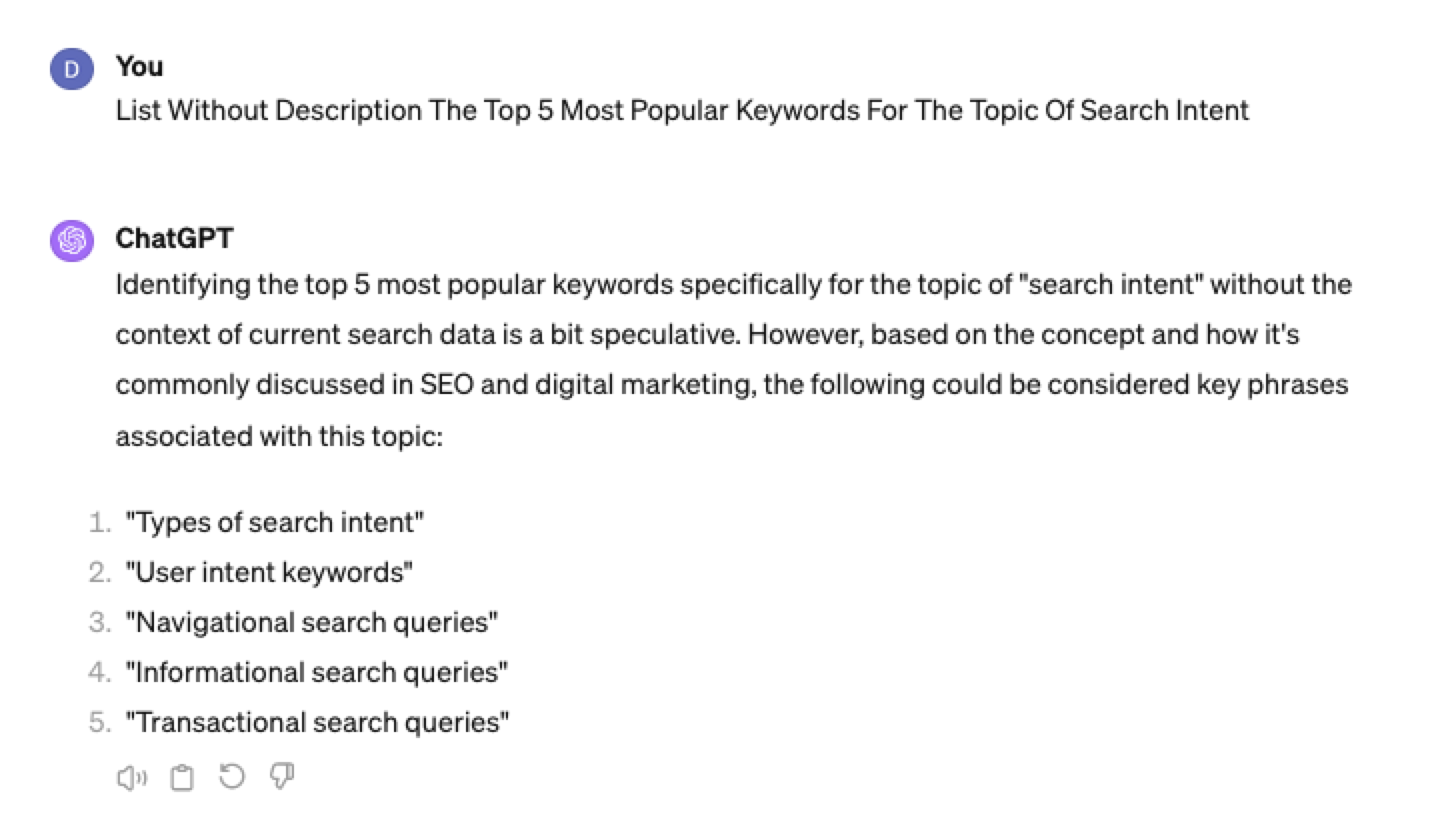 Screenshot ChatGPT 4,April 2024
Screenshot ChatGPT 4,April 2024List Without Description The Top Semantically Related Keywords And Entities For The Topic {X}
You can even ask ChatGPT what any topic’s semantically related keywords and entities are!
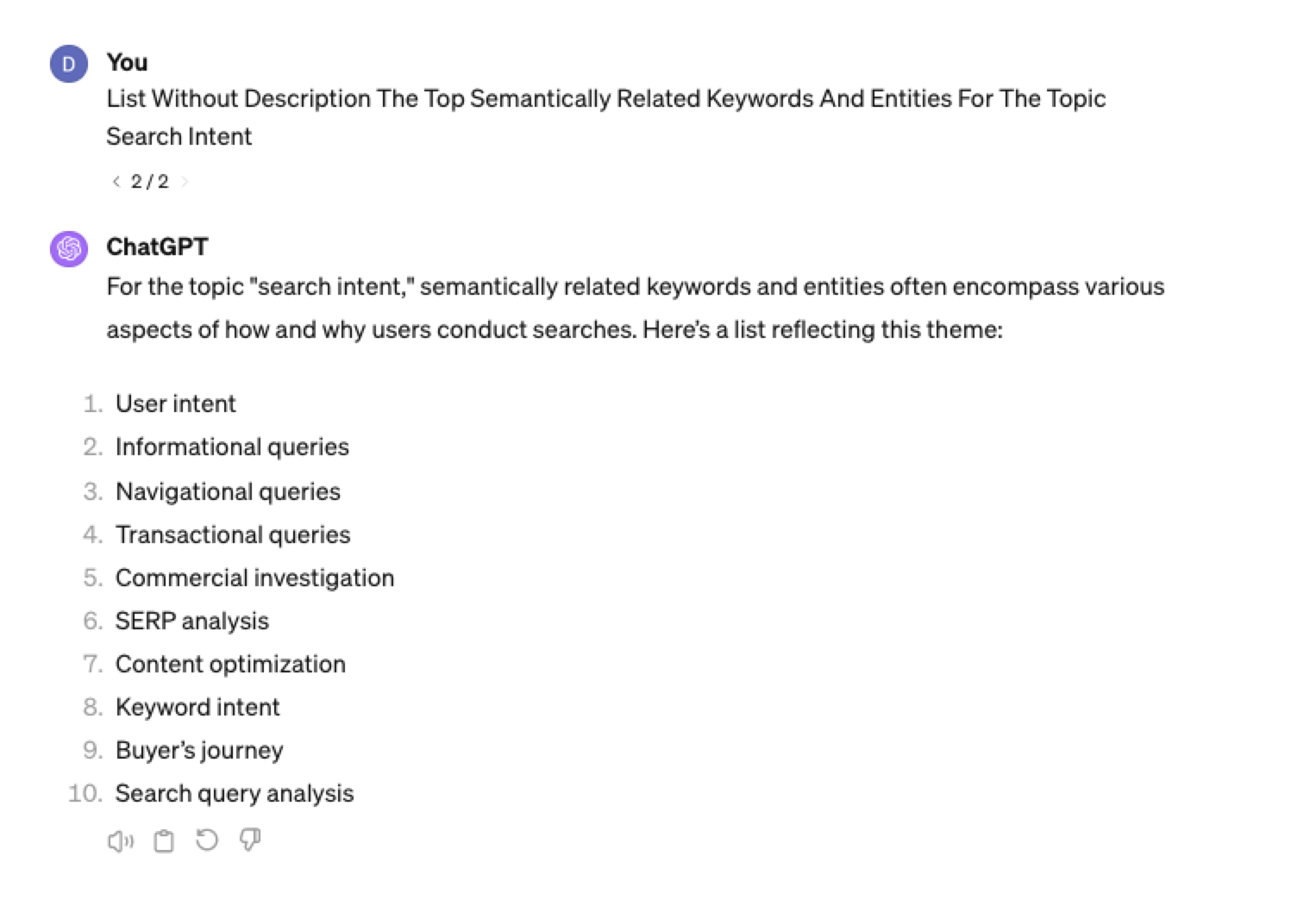 Screenshot ChatGPT 4, April 2024
Screenshot ChatGPT 4, April 2024Tip: The Onion Method Of Prompting ChatGPT
When you are happy with a series of prompts, add them all to one prompt. For example, so far in this article, we have asked ChatGPT the following:
- What are the four most popular sub-topics related to SEO?
- What are the four most popular sub-topics related to keyword research
- List without description the top five most popular keywords for “keyword intent”?
- List without description the top five most popular long-tail keywords for the topic “keyword intent types”?
- List without description the top semantically related keywords and entities for the topic “types of keyword intent in SEO.”
Combine all five into one prompt by telling ChatGPT to perform a series of steps. Example:
“Perform the following steps in a consecutive order Step 1, Step 2, Step 3, Step 4, and Step 5”
Example:
“Perform the following steps in a consecutive order Step 1, Step 2, Step 3, Step 4 and Step 5. Step 1 – Generate an answer for the 3 most popular sub-topics related to {Topic}?. Step 2 – Generate 3 of the most popular sub-topics related to each answer. Step 3 – Take those answers and list without description their top 3 most popular keywords. Step 4 – For the answers given of their most popular keywords, provide 3 long-tail keywords. Step 5 – for each long-tail keyword offered in the response, a list without descriptions 3 of their top semantically related keywords and entities.”
Generating Keyword Ideas Based On A Question
Taking the steps approach from above, we can get ChatGPT to help streamline getting keyword ideas based on a question. For example, let’s ask, “What is SEO?”
“Perform the following steps in a consecutive order Step 1, Step 2, Step 3, and Step 4. Step 1 Generate 10 questions about “{Question}”?. Step 2 – Generate 5 more questions about “{Question}” that do not repeat the above. Step 3 – Generate 5 more questions about “{Question}” that do not repeat the above. Step 4 – Based on the above Steps 1,2,3 suggest a final list of questions avoiding duplicates or semantically similar questions.”
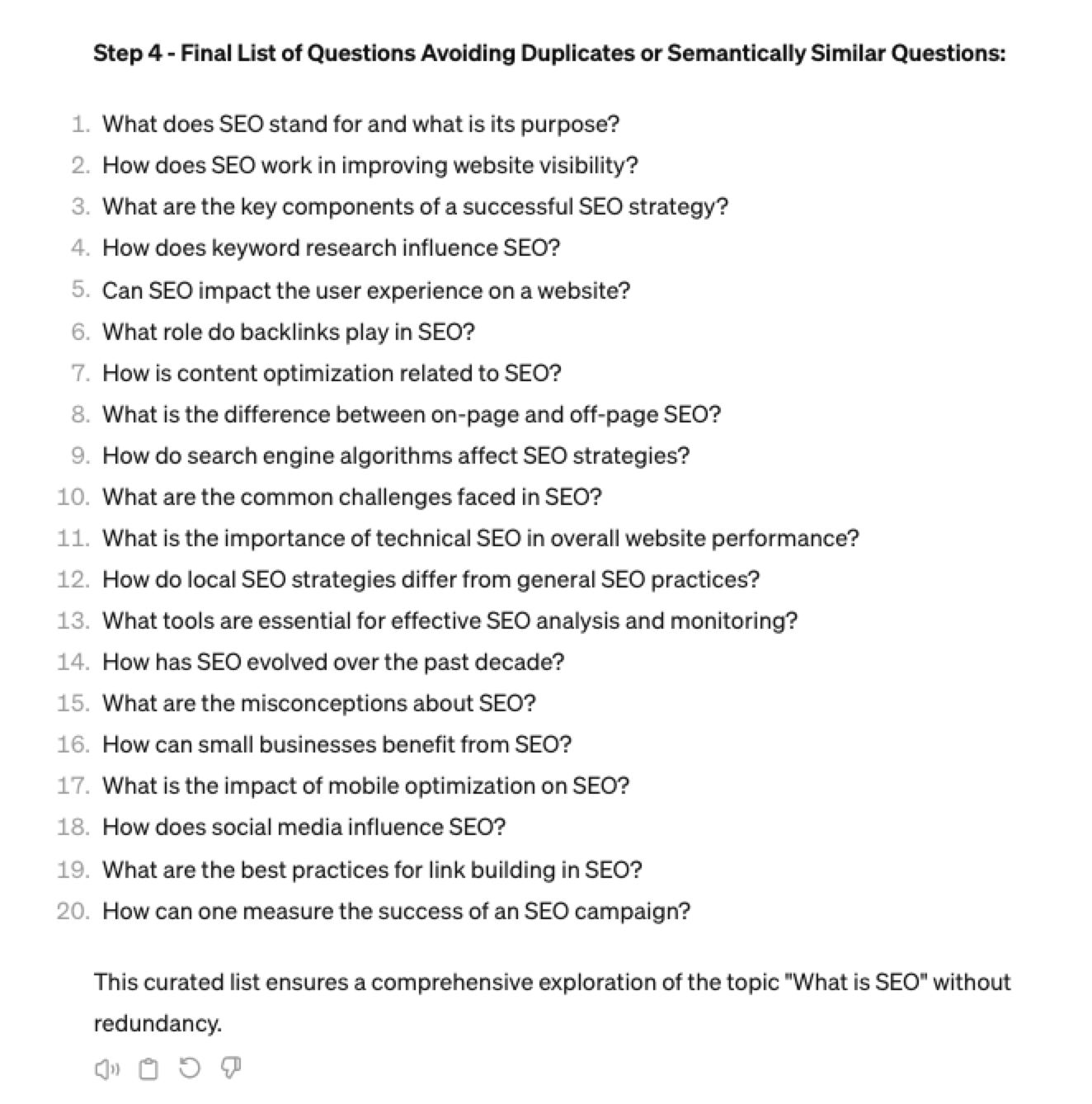 Screenshot ChatGPT 4, April 2024
Screenshot ChatGPT 4, April 2024Generating Keyword Ideas Using ChatGPT Based On The Alphabet Soup Method
One of my favorite methods, manually, without even using a keyword research tool, is to generate keyword research ideas from Google autocomplete, going from A to Z.
-
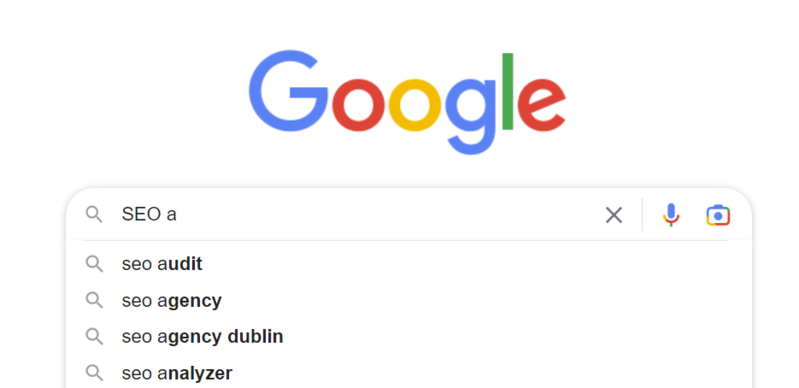 Screenshot from Google autocomplete, April 2024
Screenshot from Google autocomplete, April 2024
You can also do this using ChatGPT.
Example prompt:
“give me popular keywords that includes the keyword “SEO”, and the next letter of the word starts with a”
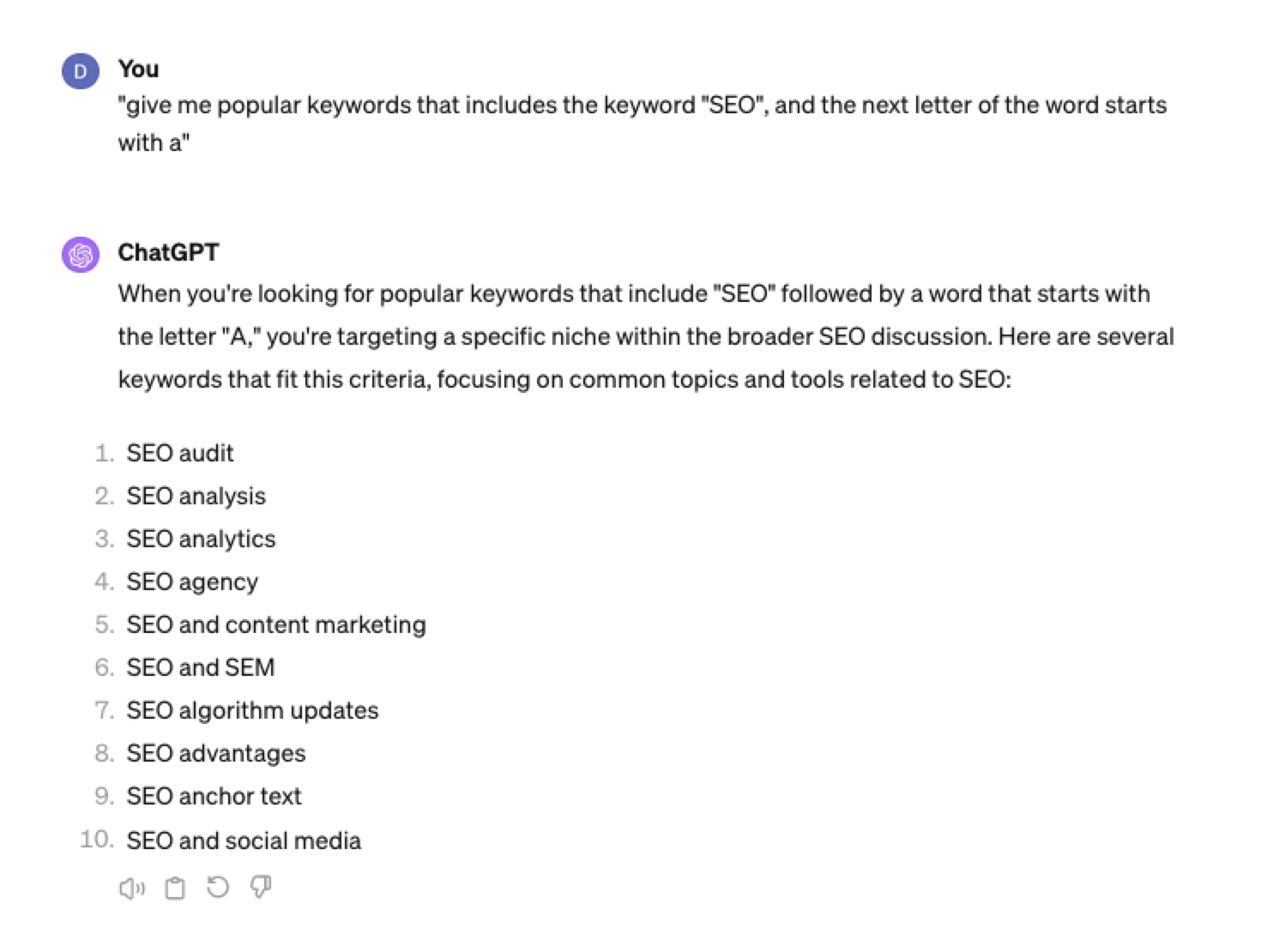 Screenshot from ChatGPT 4, April 2024
Screenshot from ChatGPT 4, April 2024Tip: Using the onion prompting method above, we can combine all this in one prompt.
“Give me five popular keywords that include “SEO” in the word, and the following letter starts with a. Once the answer has been done, move on to giving five more popular keywords that include “SEO” for each letter of the alphabet b to z.”
Generating Keyword Ideas Based On User Personas
When it comes to keyword research, understanding user personas is essential for understanding your target audience and keeping your keyword research focused and targeted. ChatGPT may help you get an initial understanding of customer personas.
Example prompt:
“For the topic of “{Topic}” list 10 keywords each for the different types of user personas”
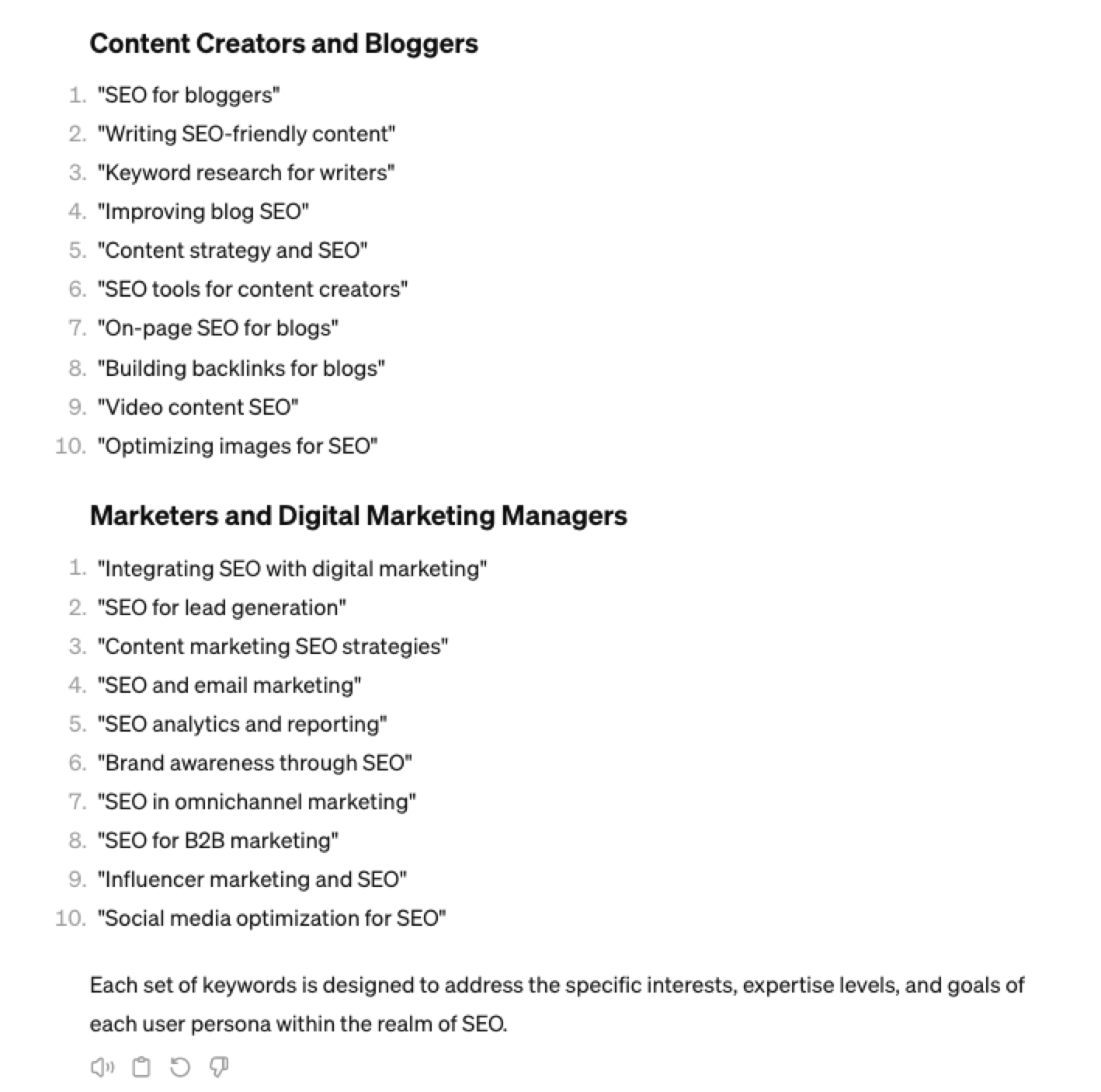 Screenshot from ChatGPT 4, April 2024
Screenshot from ChatGPT 4, April 2024You could even go a step further and ask for questions based on those topics that those specific user personas may be searching for:
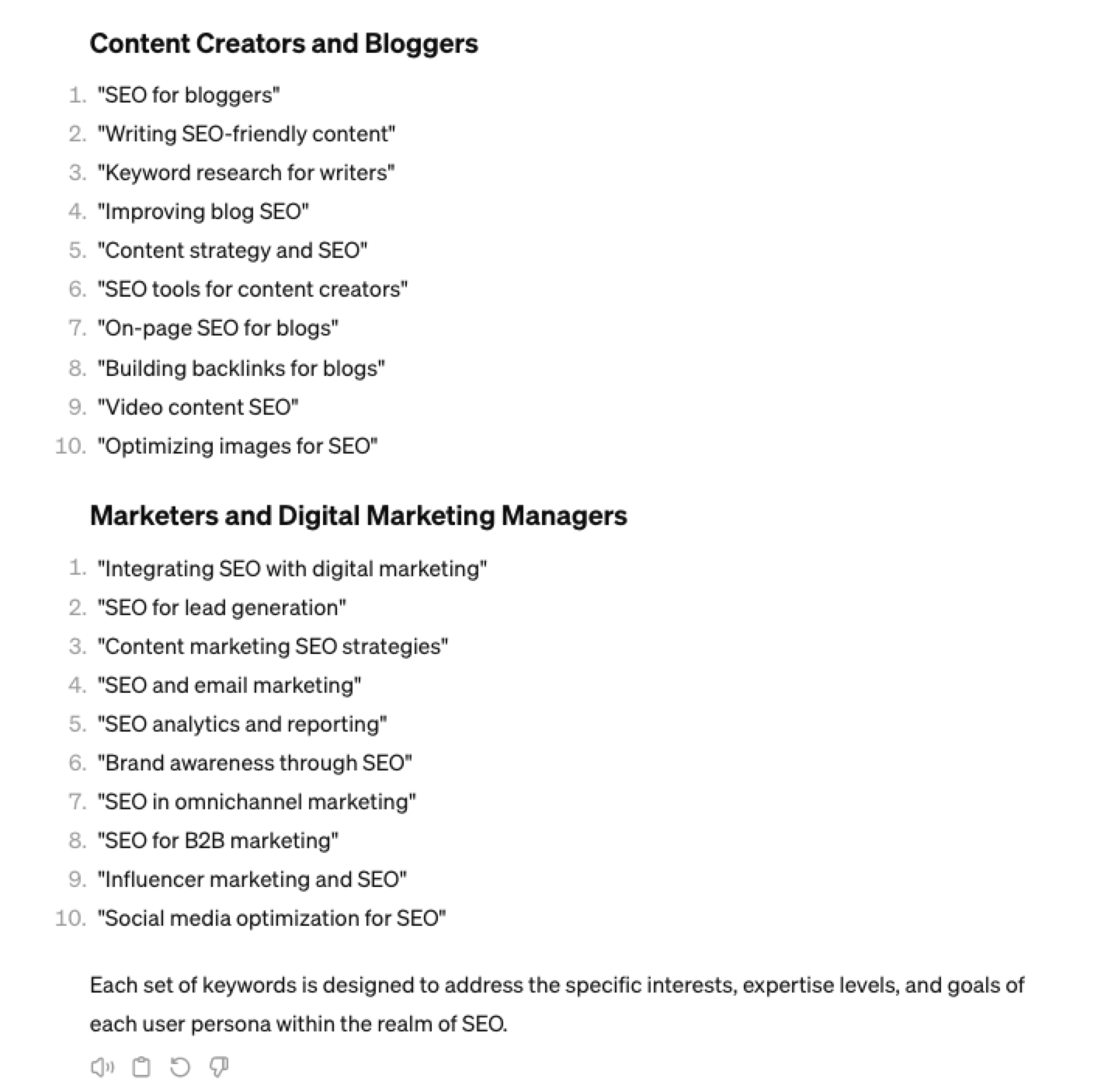 Screenshot ChatGPT 4, April 2024
Screenshot ChatGPT 4, April 2024As well as get the keywords to target based on those questions:
“For each question listed above for each persona, list the keywords, as well as the long-tail keywords to target, and put them in a table”
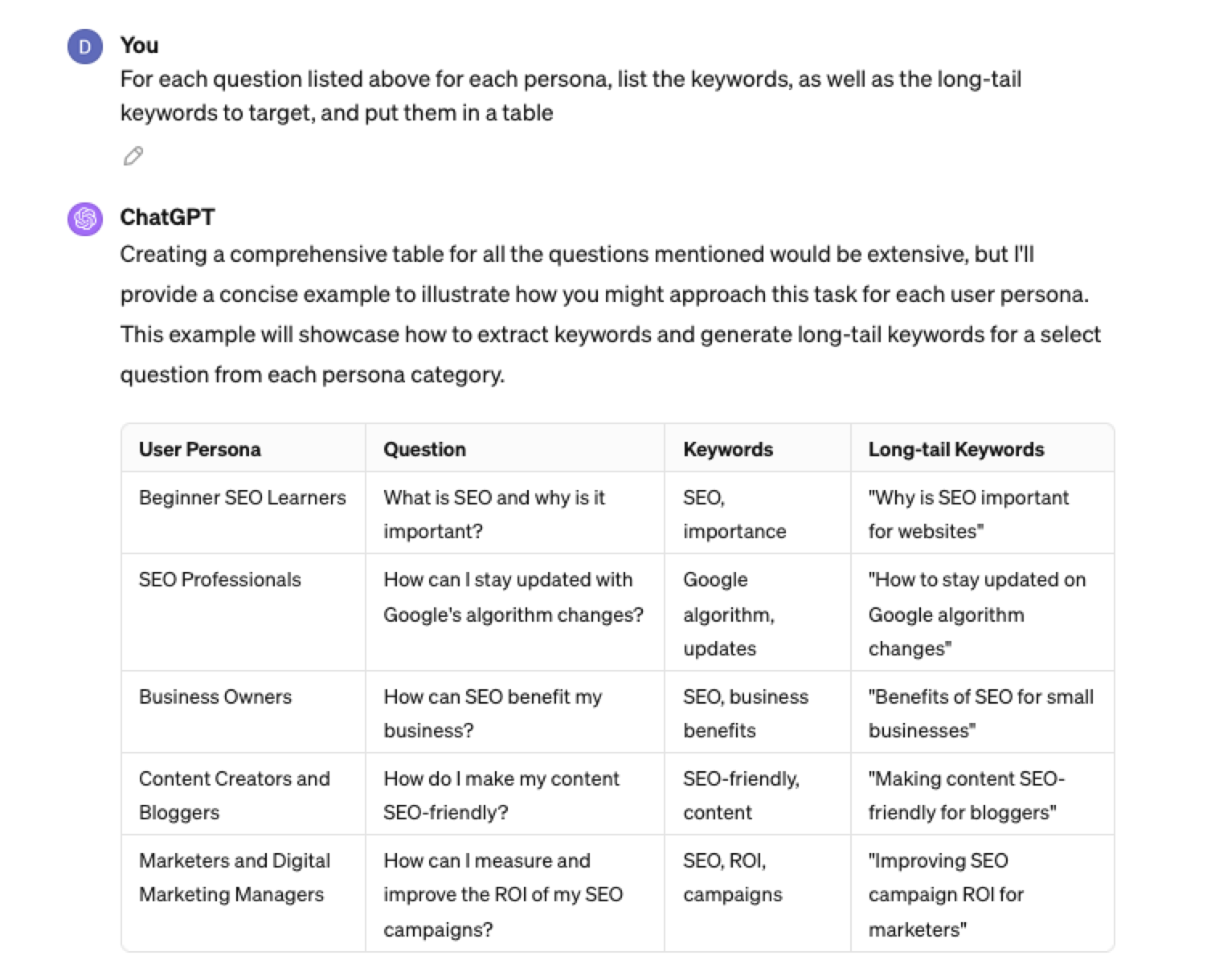 Screenshot from ChatGPT 4, April 2024
Screenshot from ChatGPT 4, April 2024Generating Keyword Ideas Using ChatGPT Based On Searcher Intent And User Personas
Understanding the keywords your target persona may be searching is the first step to effective keyword research. The next step is to understand the search intent behind those keywords and which content format may work best.
For example, a business owner who is new to SEO or has just heard about it may be searching for “what is SEO.”
However, if they are further down the funnel and in the navigational stage, they may search for “top SEO firms.”
You can query ChatGPT to inspire you here based on any topic and your target user persona.
SEO Example:
“For the topic of “{Topic}” list 10 keywords each for the different types of searcher intent that a {Target Persona} would be searching for”
ChatGPT For Keyword Research Admin
Here is how you can best use ChatGPT for keyword research admin tasks.
Using ChatGPT As A Keyword Categorization Tool
One of the use cases for using ChatGPT is for keyword categorization.
In the past, I would have had to devise spreadsheet formulas to categorize keywords or even spend hours filtering and manually categorizing keywords.
ChatGPT can be a great companion for running a short version of this for you.
Let’s say you have done keyword research in a keyword research tool, have a list of keywords, and want to categorize them.
You could use the following prompt:
“Filter the below list of keywords into categories, target persona, searcher intent, search volume and add information to a six-column table: List of keywords – [LIST OF KEYWORDS], Keyword Search Volume [SEARCH VOLUMES] and Keyword Difficulties [KEYWORD DIFFICUTIES].”
-
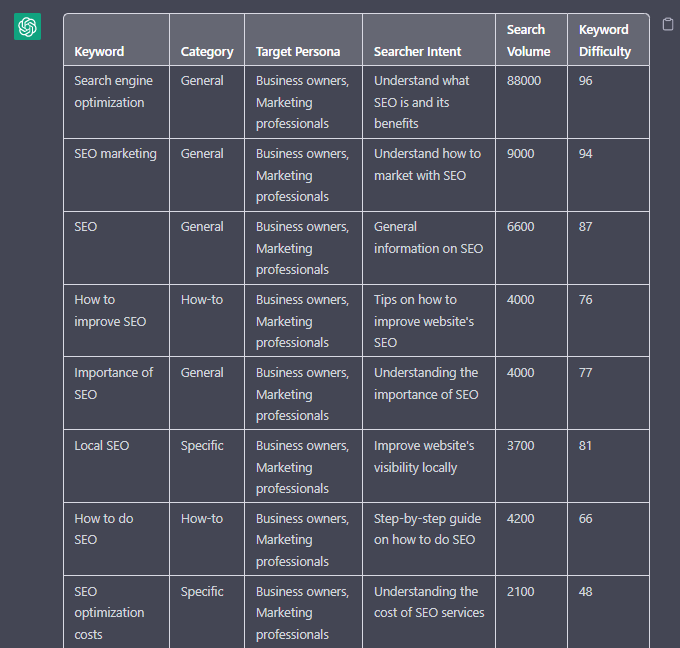 Screenshot from ChatGPT, April 2024
Screenshot from ChatGPT, April 2024
Tip: Add keyword metrics from the keyword research tools, as using the search volumes that a ChatGPT prompt may give you will be wildly inaccurate at best.
Using ChatGPT For Keyword Clustering
Another of ChatGPT’s use cases for keyword research is to help you cluster. Many keywords have the same intent, and by grouping related keywords, you may find that one piece of content can often target multiple keywords at once.
However, be careful not to rely only on LLM data for clustering. What ChatGPT may cluster as a similar keyword, the SERP or the user may not agree with. But it is a good starting point.
The big downside of using ChatGPT for keyword clustering is actually the amount of keyword data you can cluster based on the memory limits.
So, you may find a keyword clustering tool or script that is better for large keyword clustering tasks. But for small amounts of keywords, ChatGPT is actually quite good.
A great use small keyword clustering use case using ChatGPT is for grouping People Also Ask (PAA) questions.
Use the following prompt to group keywords based on their semantic relationships. For example:
“Organize the following keywords into groups based on their semantic relationships, and give a short name to each group: [LIST OF PAA], create a two-column table where each keyword sits on its own row.
-
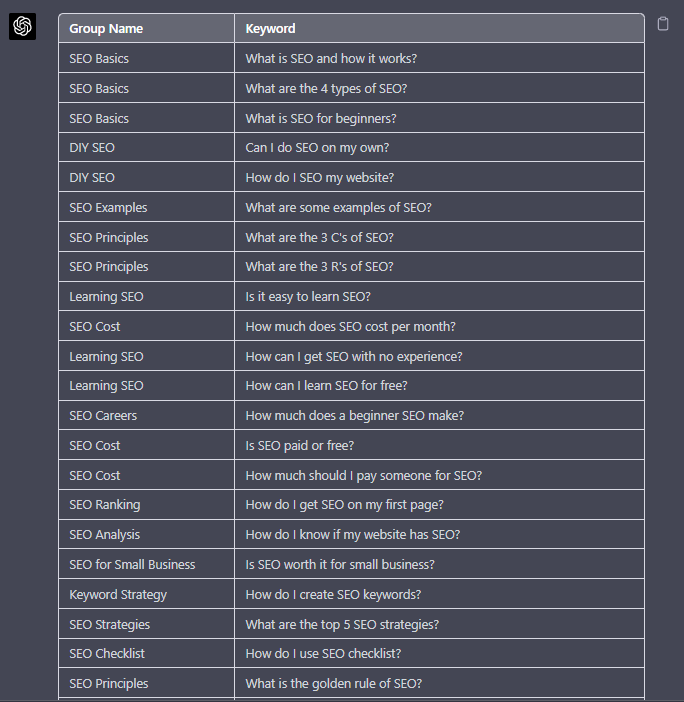 Screenshot from ChatGPT, April 2024
Screenshot from ChatGPT, April 2024
Using Chat GPT For Keyword Expansion By Patterns
One of my favorite methods of doing keyword research is pattern spotting.
Most seed keywords have a variable that can expand your target keywords.
Here are a few examples of patterns:
1. Question Patterns
(who, what, where, why, how, are, can, do, does, will)
“Generate [X] keywords for the topic “[Topic]” that contain any or all of the following “who, what, where, why, how, are, can, do, does, will”
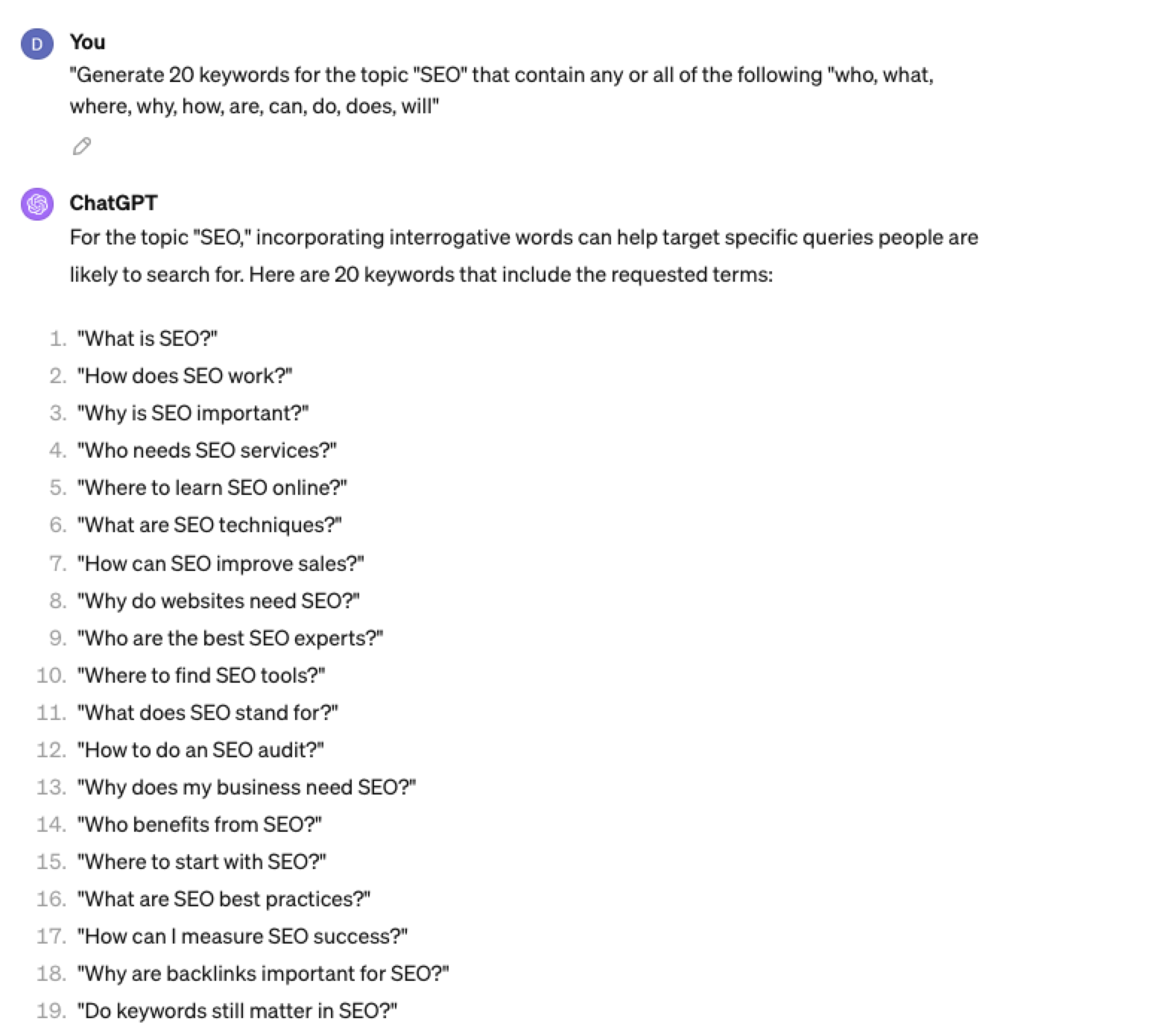 Screenshot ChatGPT 4, April 2024
Screenshot ChatGPT 4, April 20242. Comparison Patterns
Example:
“Generate 50 keywords for the topic “{Topic}” that contain any or all of the following “for, vs, alternative, best, top, review”
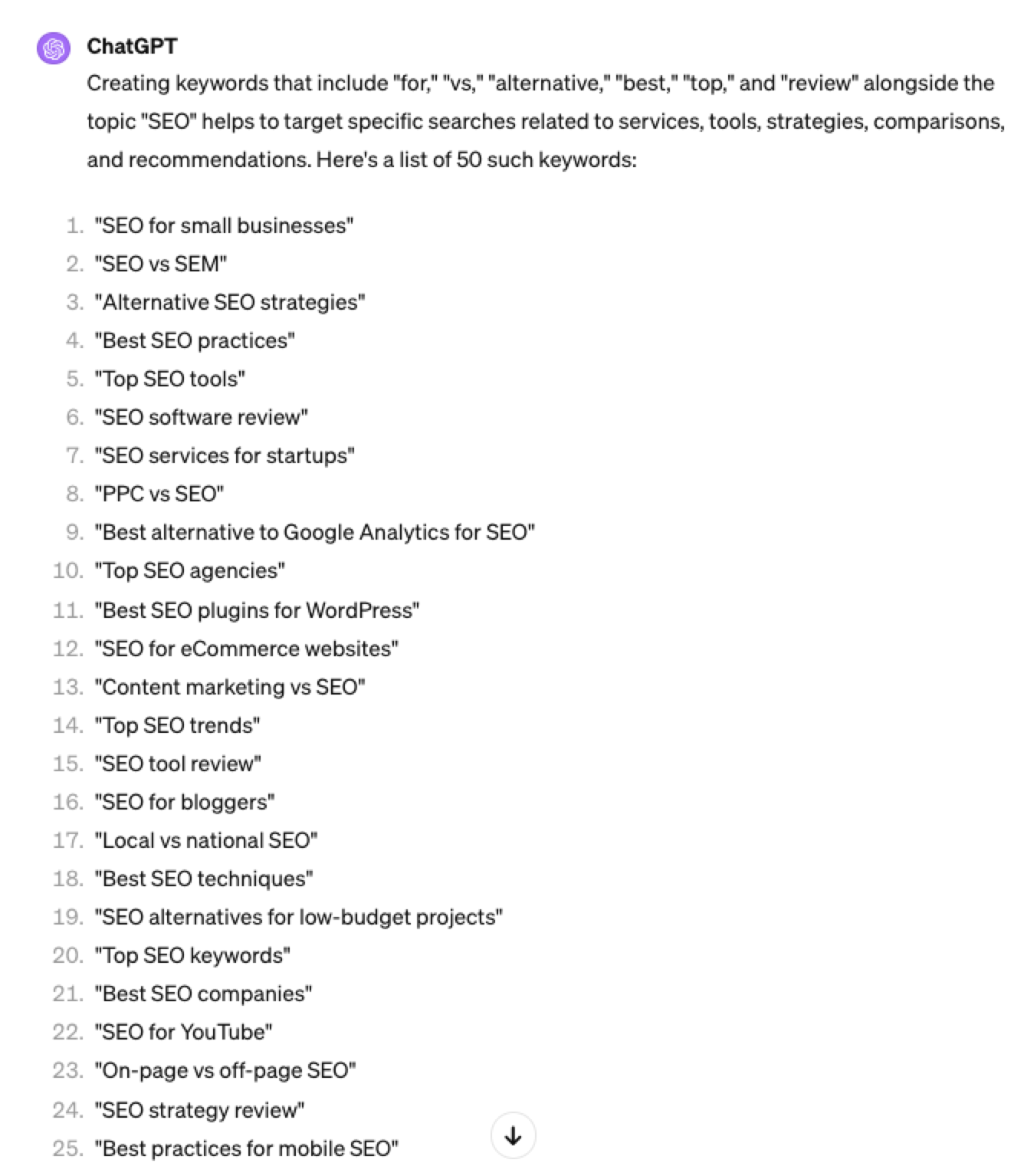 Screenshot ChatGPT 4, April 2024
Screenshot ChatGPT 4, April 20243. Brand Patterns
Another one of my favorite modifiers is a keyword by brand.
We are probably all familiar with the most popular SEO brands; however, if you aren’t, you could ask your AI friend to do the heavy lifting.
Example prompt:
“For the top {Topic} brands what are the top “vs” keywords”
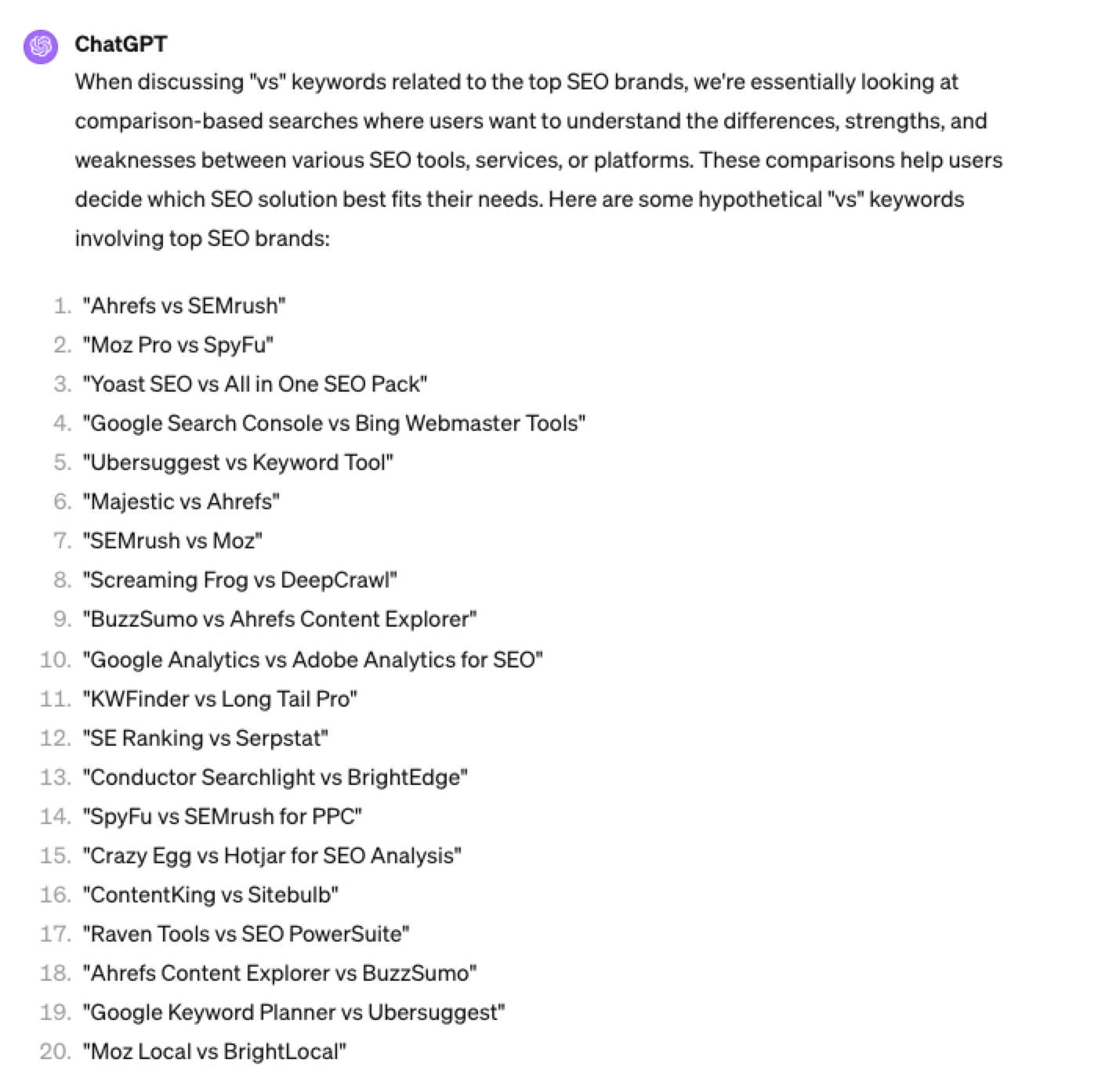 Screenshot ChatGPT 4, April 2024
Screenshot ChatGPT 4, April 20244. Search Intent Patterns
One of the most common search intent patterns is “best.”
When someone is searching for a “best {topic}” keyword, they are generally searching for a comprehensive list or guide that highlights the top options, products, or services within that specific topic, along with their features, benefits, and potential drawbacks, to make an informed decision.
Example:
“For the topic of “[Topic]” what are the 20 top keywords that include “best”
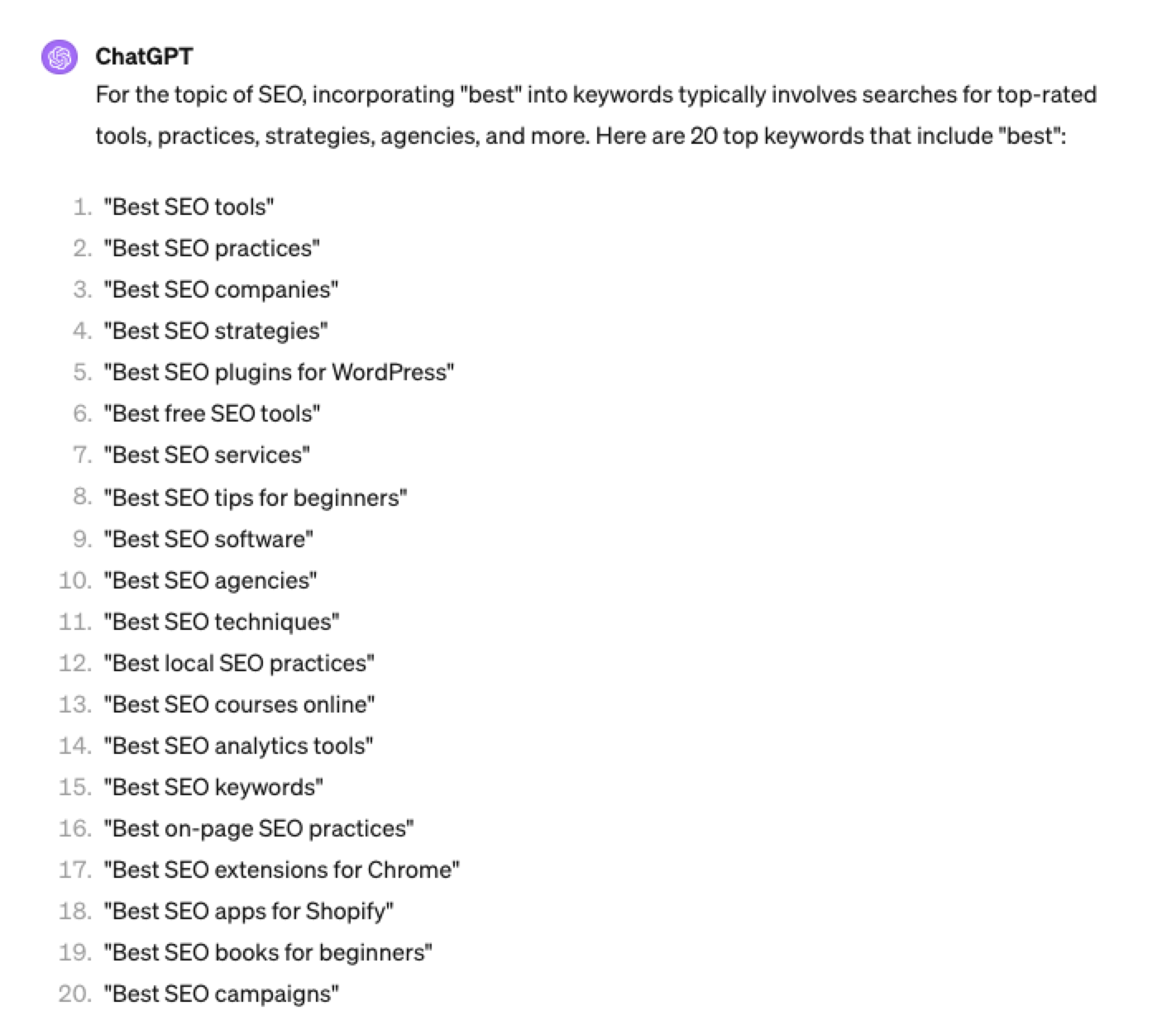 Screenshot ChatGPT 4, April 2024
Screenshot ChatGPT 4, April 2024Again, this guide to keyword research using ChatGPT has emphasized the ease of generating keyword research ideas by utilizing ChatGPT throughout the process.
Keyword Research Using ChatGPT Vs. Keyword Research Tools
Free Vs. Paid Keyword Research Tools
Like keyword research tools, ChatGPT has free and paid options.
However, one of the most significant drawbacks of using ChatGPT for keyword research alone is the absence of SEO metrics to help you make smarter decisions.
To improve accuracy, you could take the results it gives you and verify them with your classic keyword research tool – or vice versa, as shown above, uploading accurate data into the tool and then prompting.
However, you must consider how long it takes to type and fine-tune your prompt to get your desired data versus using the filters within popular keyword research tools.
For example, if we use a popular keyword research tool using filters, you could have all of the “best” queries with all of their SEO metrics:
-
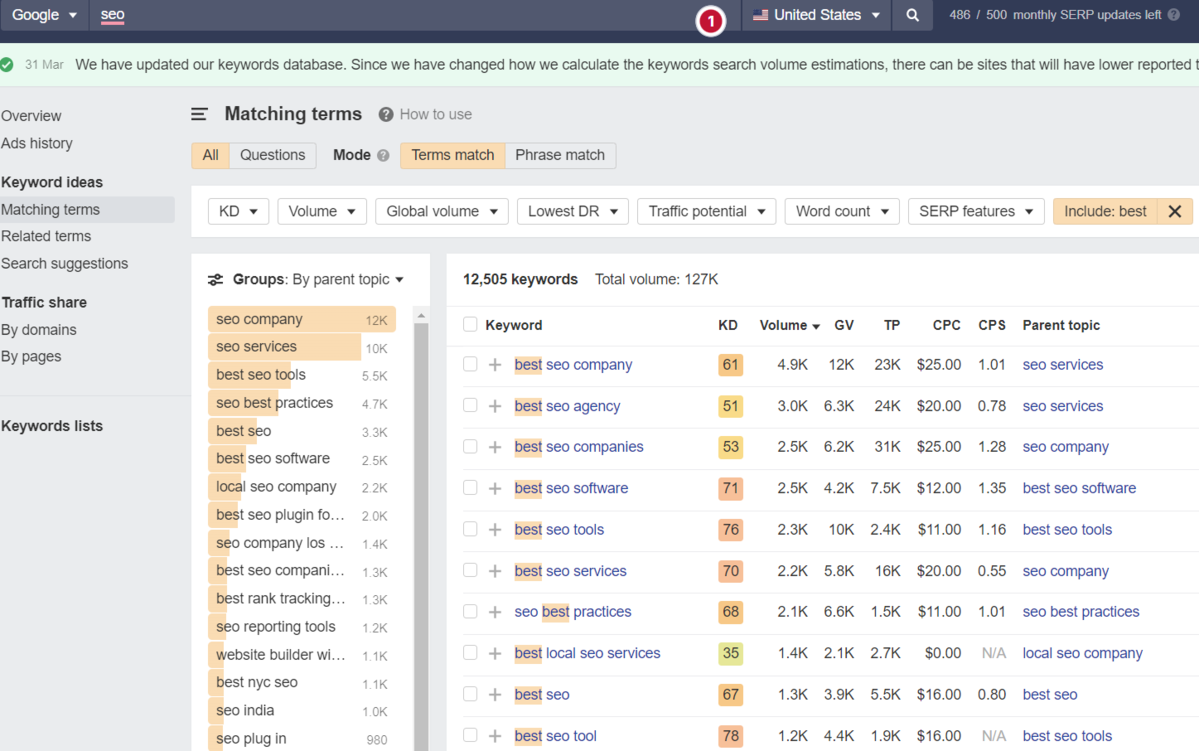 Screenshot from Ahrefs Keyword Explorer, March 2024
Screenshot from Ahrefs Keyword Explorer, March 2024
And unlike ChatGPT, generally, there is no token limit; you can extract several hundred, if not thousands, of keywords at a time.
As I have mentioned multiple times throughout this piece, you cannot blindly trust the data or SEO metrics it may attempt to provide you with.
The key is to validate the keyword research with a keyword research tool.
ChatGPT For International SEO Keyword Research
ChatGPT can be a terrific multilingual keyword research assistant.
For example, if you wanted to research keywords in a foreign language such as French. You could ask ChatGPT to translate your English keywords;
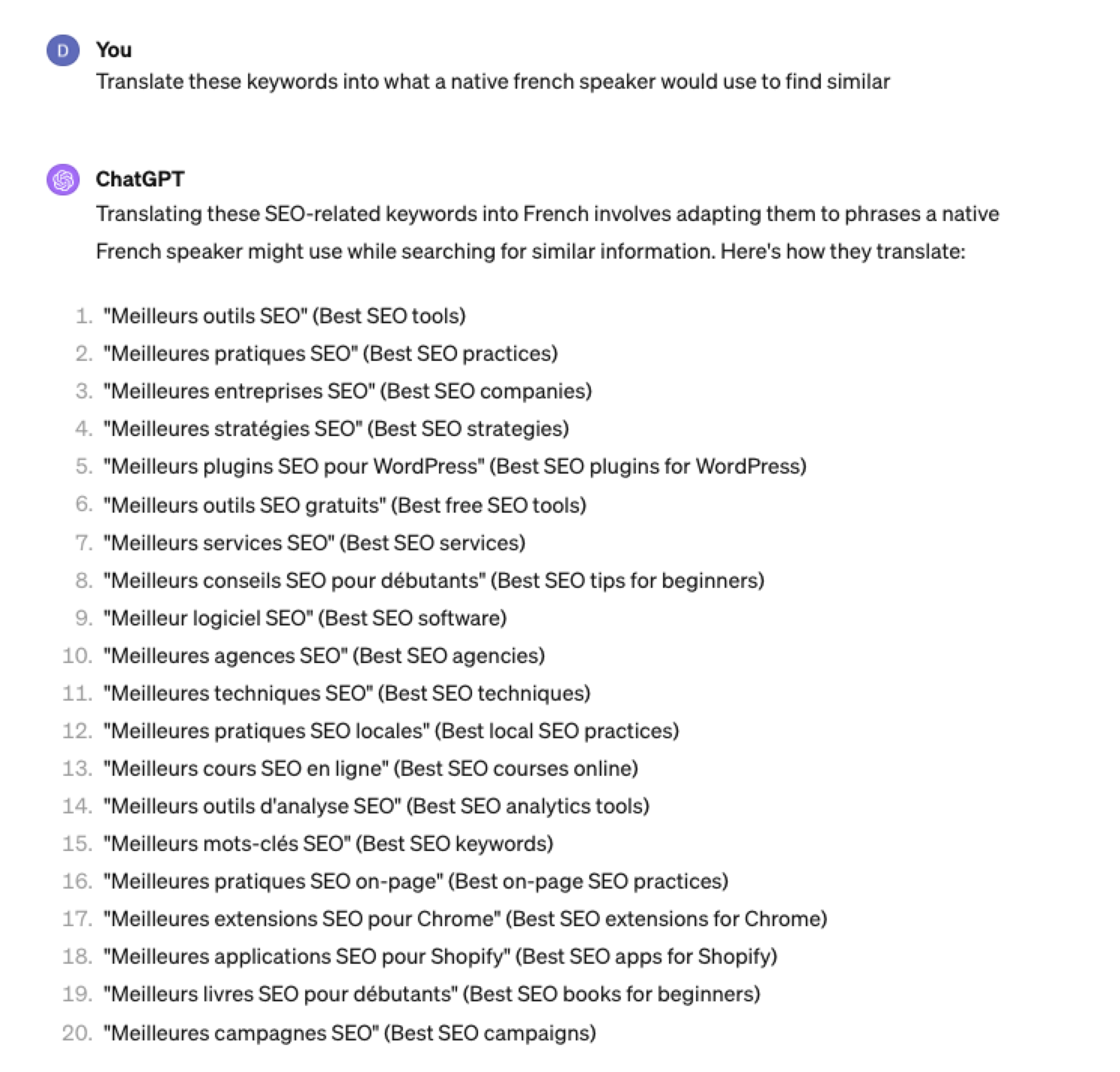 Screenshot ChatGPT 4, Apil 2024
Screenshot ChatGPT 4, Apil 2024- The key is to take the data above and paste it into a popular keyword research tool to verify.
- As you can see below, many of the keyword translations for the English keywords do not have any search volume for direct translations in French.
 Screenshot from Ahrefs Keyword Explorer, April 2024
Screenshot from Ahrefs Keyword Explorer, April 2024But don’t worry, there is a workaround: If you have access to a competitor keyword research tool, you can see what webpage is ranking for that query – and then identify the top keyword for that page based on the ChatGPT translated keywords that do have search volume.
-
-
 Screenshot from Ahrefs Keyword Explorer, April 2024
Screenshot from Ahrefs Keyword Explorer, April 2024
Or, if you don’t have access to a paid keyword research tool, you could always take the top-performing result, extract the page copy, and then ask ChatGPT what the primary keyword for the page is.
Key Takeaway
-
ChatGPT can be an expert on any topic and an invaluable keyword research tool. However, it is another tool to add to your toolbox when doing keyword research; it does not replace traditional keyword research tools.
As shown throughout this tutorial, from making up keywords at the beginning to inaccuracies around data and translations, ChatGPT can make mistakes when used for keyword research.
You cannot blindly trust the data you get back from ChatGPT.
However, it can offer a shortcut to understanding any topic for which you need to do keyword research and, as a result, save you countless hours.
But the key is how you prompt.
The prompts I shared with you above will help you understand a topic in minutes instead of hours and allow you to better seed keywords using keyword research tools.
It can even replace mundane keyword clustering tasks that you used to do with formulas in spreadsheets or generate ideas based on keywords you give it.
Paired with traditional keyword research tools, ChatGPT for keyword research can be a powerful tool in your arsenal.
More resources:
Featured Image: Tatiana Shepeleva/Shutterstock
SEO
OpenAI Expected to Integrate Real-Time Data In ChatGPT

Sam Altman, CEO of OpenAI, dispelled rumors that a new search engine would be announced on Monday, May 13. Recent deals have raised the expectation that OpenAI will announce the integration of real-time content from English, Spanish, and French publications into ChatGPT, complete with links to the original sources.
OpenAI Search Is Not Happening
Many competing search engines have tried and failed to challenge Google as the leading search engine. A new wave of hybrid generative AI search engines is currently trying to knock Google from the top spot with arguably very little success.
Sam Altman is on record saying that creating a search engine to compete against Google is not a viable approach. He suggested that technological disruption was the way to replace Google by changing the search paradigm altogether. The speculation that Altman is going to announce a me-too search engine on Monday never made sense given his recent history of dismissing the concept as a non-starter.
So perhaps it’s not a surprise that he recently ended the speculation by explicitly saying that he will not be announcing a search engine on Monday.
He tweeted:
“not gpt-5, not a search engine, but we’ve been hard at work on some new stuff we think people will love! feels like magic to me.”
“New Stuff” May Be Iterative Improvement
It’s quite likely that what’s going to be announced is iterative which means it improves ChatGPT but not replaces it. This fits into how Altman recently expressed his approach with ChatGPT.
He remarked:
“And it does kind of suck to ship a product that you’re embarrassed about, but it’s much better than the alternative. And in this case in particular, where I think we really owe it to society to deploy iteratively.
There could totally be things in the future that would change where we think iterative deployment isn’t such a good strategy, but it does feel like the current best approach that we have and I think we’ve gained a lot from from doing this and… hopefully the larger world has gained something too.”
Improving ChatGPT iteratively is Sam Altman’s preference and recent clues point to what those changes may be.
Recent Deals Contain Clues
OpenAI has been making deals with news media and User Generated Content publishers since December 2023. Mainstream media has reported these deals as being about licensing content for training large language models. But they overlooked a a key detail that we reported on last month which is that these deals give OpenAI access to real-time information that they stated will be used to give attribution to that real-time data in the form of links.
That means that ChatGPT users will gain the ability to access real-time news and to use that information creatively within ChatGPT.
Dotdash Meredith Deal
Dotdash Meredith (DDM) is the publisher of big brand publications such as Better Homes & Gardens, FOOD & WINE, InStyle, Investopedia, and People magazine. The deal that was announced goes way beyond using the content as training data. The deal is explicitly about surfacing the Dotdash Meredith content itself in ChatGPT.
The announcement stated:
“As part of the agreement, OpenAI will display content and links attributed to DDM in relevant ChatGPT responses. …This deal is a testament to the great work OpenAI is doing on both fronts to partner with creators and publishers and ensure a healthy Internet for the future.
Over 200 million Americans each month trust our content to help them make decisions, solve problems, find inspiration, and live fuller lives. This partnership delivers the best, most relevant content right to the heart of ChatGPT.”
A statement from OpenAI gives credibility to the speculation that OpenAI intends to directly show licensed third-party content as part of ChatGPT answers.
OpenAI explained:
“We’re thrilled to partner with Dotdash Meredith to bring its trusted brands to ChatGPT and to explore new approaches in advancing the publishing and marketing industries.”
Something that DDM also gets out of this deal is that OpenAI will enhance DDM’s in-house ad targeting in order show more tightly focused contextual advertising.
Le Monde And Prisa Media Deals
In March 2024 OpenAI announced a deal with two global media companies, Le Monde and Prisa Media. Le Monde is a French news publication and Prisa Media is a Spanish language multimedia company. The interesting aspects of these two deals is that it gives OpenAI access to real-time data in French and Spanish.
Prisa Media is a global Spanish language media company based in Madrid, Spain that is comprised of magazines, newspapers, podcasts, radio stations, and television networks. It’s reach extends from Spain to America. American media companies include publications in the United States, Argentina, Bolivia, Chile, Colombia, Costa Rica, Ecuador, Mexico, and Panama. That is a massive amount of real-time information in addition to a massive audience of millions.
OpenAI explicitly announced that the purpose of this deal was to bring this content directly to ChatGPT users.
The announcement explained:
“We are continually making improvements to ChatGPT and are supporting the essential role of the news industry in delivering real-time, authoritative information to users. …Our partnerships will enable ChatGPT users to engage with Le Monde and Prisa Media’s high-quality content on recent events in ChatGPT, and their content will also contribute to the training of our models.”
That deal is not just about training data. It’s about bringing current events data to ChatGPT users.
The announcement elaborated in more detail:
“…our goal is to enable ChatGPT users around the world to connect with the news in new ways that are interactive and insightful.”
As noted in our April 30th article that revealed that OpenAI will show links in ChatGPT, OpenAI intends to show third party content with links to that content.
OpenAI commented on the purpose of the Le Monde and Prisa Media partnership:
“Over the coming months, ChatGPT users will be able to interact with relevant news content from these publishers through select summaries with attribution and enhanced links to the original articles, giving users the ability to access additional information or related articles from their news sites.”
There are additional deals with other groups like The Financial Times which also stress that this deal will result in a new ChatGPT feature that will allow users to interact with real-time news and current events .
OpenAI’s Monday May 13 Announcement
There are many clues that the announcement on Monday will be that ChatGPT users will gain the ability to interact with content about current events. This fits into the terms of recent deals with news media organizations. There may be other features announced as well but this part is something that there are many clues pointing to.
Watch Altman’s interview at Stanford University
Featured Image by Shutterstock/photosince
SEO
Google’s Strategies For Dealing With Content Decay

In the latest episode of the Search Off The Record podcast, Google Search Relations team members John Mueller and Lizzi Sassman did a deep dive into dealing with “content decay” on websites.
Outdated content is a natural issue all sites face over time, and Google has outlined strategies beyond just deleting old pages.
While removing stale content is sometimes necessary, Google recommends taking an intentional, format-specific approach to tackling content decay.
Archiving vs. Transitional Guides
Google advises against immediately removing content that becomes obsolete, like materials referencing discontinued products or services.
Removing content too soon could confuse readers and lead to a poor experience, Sassman explains:
“So, if I’m trying to find out like what happened, I almost need that first thing to know. Like, “What happened to you?” And, otherwise, it feels almost like an error. Like, “Did I click a wrong link or they redirect to the wrong thing?””
Sassman says you can avoid confusion by providing transitional “explainer” pages during deprecation periods.
A temporary transition guide informs readers of the outdated content while steering them toward updated resources.
Sassman continues:
“That could be like an intermediary step where maybe you don’t do that forever, but you do it during the transition period where, for like six months, you have them go funnel them to the explanation, and then after that, all right, call it a day. Like enough people know about it. Enough time has passed. We can just redirect right to the thing and people aren’t as confused anymore.”
When To Update Vs. When To Write New Content
For reference guides and content that provide authoritative overviews, Google suggests updating information to maintain accuracy and relevance.
However, for archival purposes, major updates may warrant creating a new piece instead of editing the original.
Sassman explains:
“I still want to retain the original piece of content as it was, in case we need to look back or refer to it, and to change it or rehabilitate it into a new thing would almost be worth republishing as a new blog post if we had that much additional things to say about it.”
Remove Potentially Harmful Content
Google recommends removing pages in cases where the outdated information is potentially harmful.
Sassman says she arrived at this conclusion when deciding what to do with a guide involving obsolete structured data:
“I think something that we deleted recently was the “How to Structure Data” documentation page, which I thought we should just get rid of it… it almost felt like that’s going to be more confusing to leave it up for a period of time.
And actually it would be negative if people are still adding markup, thinking they’re going to get something. So what we ended up doing was just delete the page and redirect to the changelog entry so that, if people clicked “How To Structure Data” still, if there was a link somewhere, they could still find out what happened to that feature.”
Internal Auditing Processes
To keep your content current, Google advises implementing a system for auditing aging content and flagging it for review.
Sassman says she sets automated alerts for pages that haven’t been checked in set periods:
“Oh, so we have a little robot to come and remind us, “Hey, you should come investigate this documentation page. It’s been x amount of time. Please come and look at it again to make sure that all of your links are still up to date, that it’s still fresh.””
Context Is Key
Google’s tips for dealing with content decay center around understanding the context of outdated materials.
You want to prevent visitors from stumbling across obsolete pages without clarity.
Additional Google-recommended tactics include:
- Prominent banners or notices clarifying a page’s dated nature
- Listing original publish dates
- Providing inline annotations explaining how older references or screenshots may be obsolete
How This Can Help You
Following Google’s recommendations for tackling content decay can benefit you in several ways:
- Improved user experience: By providing clear explanations, transition guides, and redirects, you can ensure that visitors don’t encounter confusing or broken pages.
- Maintained trust and credibility: Removing potentially harmful or inaccurate content and keeping your information up-to-date demonstrates your commitment to providing reliable and trustworthy resources.
- Better SEO: Regularly auditing and updating your pages can benefit your website’s search rankings and visibility.
- Archival purposes: By creating new content instead of editing older pieces, you can maintain a historical record of your website’s evolution.
- Streamlined content management: Implementing internal auditing processes makes it easier to identify and address outdated or problematic pages.
By proactively tackling content decay, you can keep your website a valuable resource, improve SEO, and maintain an organized content library.
Listen to the full episode of Google’s podcast below:
Featured Image: Stokkete/Shutterstock
-

 PPC5 days ago
PPC5 days agoHow the TikTok Algorithm Works in 2024 (+9 Ways to Go Viral)
-

 MARKETING7 days ago
MARKETING7 days agoA Recap of Everything Marketers & Advertisers Need to Know
-

 SEO4 days ago
SEO4 days agoHow to Use Keywords for SEO: The Complete Beginner’s Guide
-

 SEO6 days ago
SEO6 days agoBlog Post Checklist: Check All Prior to Hitting “Publish”
-

 MARKETING5 days ago
MARKETING5 days agoHow To Protect Your People and Brand
-

 SEARCHENGINES6 days ago
SEARCHENGINES6 days agoGoogle Started Enforcing The Site Reputation Abuse Policy
-

 PPC6 days ago
PPC6 days agoHow to Craft Compelling Google Ads for eCommerce
-

 MARKETING6 days ago
MARKETING6 days agoElevating Women in SEO for a More Inclusive Industry






